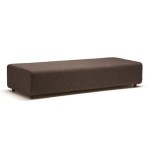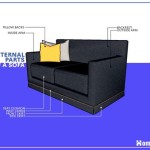How To Restuff Sofa Back Cushions
Sofa back cushions, subjected to daily use and pressure, gradually lose their plumpness and support over time. This deterioration diminishes the overall comfort and aesthetic appeal of the sofa. Restuffing the cushions is a cost-effective alternative to replacing the entire sofa. It allows for customization of firmness and can significantly extend the lifespan of the furniture. Understanding the process and available materials is crucial for achieving optimal results.
Prior to embarking on the restuffing process, assessing the condition of the existing cushions is paramount. Evaluate the extent of the stuffing loss, the state of the fabric covering, and the presence of any tears or damage. This assessment will inform the choice of materials and the necessary repair steps. A thorough assessment also helps in determining the required quantity of new stuffing material.
Gathering the necessary tools and materials is the next essential step. The required tools usually include a seam ripper, scissors, measuring tape, sewing machine (optional, for more extensive repairs), needle and thread, and potentially fabric glue or patching material if the cushion cover requires repairs. The choice of stuffing material will depend on the desired level of firmness and budget. Common options include polyester fiberfill, down feathers, foam, and shredded foam. Each material offers distinct characteristics in terms of comfort, durability, and cost.
Selecting the Right Stuffing Material
The choice of stuffing material is a critical factor influencing the final outcome of the restuffing project. Each material possesses unique properties that affect the feel, support, and longevity of the cushions. A careful consideration of these properties is necessary to achieve the desired level of comfort and aesthetic appeal.
Polyester fiberfill is a widely used and affordable option. It is lightweight, hypoallergenic, and readily available. Polyester fiberfill provides a soft and plush feel, making it suitable for individuals who prefer a more relaxed and less structured cushion. However, it tends to flatten and lose its shape over time, requiring more frequent restuffing compared to other materials. The density of the fiberfill can also vary, impacting the firmness level. Higher-density fiberfill offers better support and resilience.
Down feathers offer a luxurious and exceptionally soft feel. They are known for their excellent insulation properties and ability to conform to the body's shape. Down feathers provide a unique level of comfort and are often preferred for high-end sofas. However, down feathers are considerably more expensive than other stuffing materials and require careful maintenance to prevent clumping. They are also not suitable for individuals with allergies to feathers.
Foam is a durable and supportive option, available in various densities and firmness levels. High-density foam offers superior support and resistance to compression, making it ideal for individuals who prefer firmer cushions. Foam can be purchased in sheets or pre-cut pieces, allowing for customization of the cushion's shape and size. It is also relatively easy to work with and maintain. However, foam can be more expensive than polyester fiberfill and may not provide the same level of plushness as down feathers.
Shredded foam offers a balance between comfort and support. It is made from recycled foam scraps and provides a more textured feel compared to solid foam. Shredded foam allows for better airflow within the cushion, reducing the risk of moisture buildup and mildew growth. It is also a more environmentally friendly option compared to virgin foam. However, shredded foam can be more challenging to work with and may require more frequent fluffing to maintain its shape.
Preparing the Cushion Covers
Before adding new stuffing, the existing cushion covers must be properly prepared. This involves carefully removing the old stuffing, inspecting the fabric for damage, and making any necessary repairs. The condition of the cushion cover directly affects the overall appearance and longevity of the restuffed cushion.
Using a seam ripper, carefully detach one side of the cushion cover. Work slowly and deliberately to avoid damaging the fabric. Remove all the old stuffing and discard it appropriately. The used stuffing may contain dust mites, allergens, and remnants of the original filling breakdown, so it's essential to dispose of it properly.
Thoroughly inspect the cushion cover for any tears, holes, or weak seams. If any damage is found, repair it before proceeding with the restuffing process. Small tears can be mended with needle and thread, while larger holes may require patching with a matching fabric. Reinforce weak seams by stitching over them several times. Fabric glue can also be used to reinforce seams and prevent fraying.
If the cushion cover is heavily soiled or stained, consider washing it before restuffing. Follow the manufacturer's instructions for washing and drying to avoid damaging the fabric. Ensure that the cover is completely dry before adding the new stuffing to prevent mold growth.
Consider adding a layer of batting to the inside of the cushion cover for added protection and comfort. Batting is a thin layer of fabric that provides a smooth surface for the stuffing and prevents it from shifting or bunching. It also adds an extra layer of cushioning and improves the overall appearance of the cushion.
Restuffing and Finishing the Cushions
The actual restuffing process requires patience and attention to detail. The key is to evenly distribute the stuffing material and avoid overfilling or underfilling the cushion. The goal is to achieve a consistent and comfortable level of support throughout the entire cushion.
Begin by adding small amounts of stuffing material at a time, working from the corners and edges towards the center. Use your hands to fluff and distribute the stuffing evenly. Avoid packing the stuffing too tightly, as this can make the cushion feel hard and uncomfortable. Regularly check the shape and firmness of the cushion to ensure that it is meeting your expectations.
The amount of stuffing required will depend on the size and shape of the cushion, as well as the type of stuffing material used. Start with a conservative amount and gradually add more until the desired level of firmness is achieved. It is always better to add more stuffing later than to overfill the cushion in the first place.
Once the cushion is adequately stuffed, carefully close the opening with a needle and thread. Use a strong and durable thread that matches the color of the cushion cover. Overlap the edges of the fabric slightly and stitch them together securely. For a more professional finish, consider using a sewing machine to close the opening.
After closing the opening, fluff the cushion again to ensure that the stuffing is evenly distributed. Gently massage the cushion to smooth out any lumps or bumps. Step back and assess the overall appearance of the cushion. If necessary, add more stuffing or adjust the distribution until you are satisfied with the results.
Finally, place the restuffed cushion back on the sofa and enjoy the improved comfort and support. Regularly fluff and rotate the cushions to maintain their shape and prevent them from flattening over time. With proper care and maintenance, restuffed sofa back cushions can provide years of comfortable seating.

How To Fix Sagging Couch Cushions Thistlewood Farm

How To Fix Saggy Couch Cushions An Exercise In Frugality

Easy Inexpensive Saggy Couch Solutions Diy Makeover Love Of Family Home

How To Fix A Sloppy Back Cushion

How To Fix Sagging Couch Cushions Thistlewood Farm

Easy Inexpensive Saggy Couch Solutions Diy Makeover Love Of Family Home

How To Restuff Couch Cushions And Bring Them Back Life Hometalk

Diy How To Fix Flat Back Cushions For Sofas Or Chairs Save Big

How To Restuff Sofa Cushions Give New Life A Saggy Couch

How To Restuff Sofa Cushions Plumbs Reupholstery








